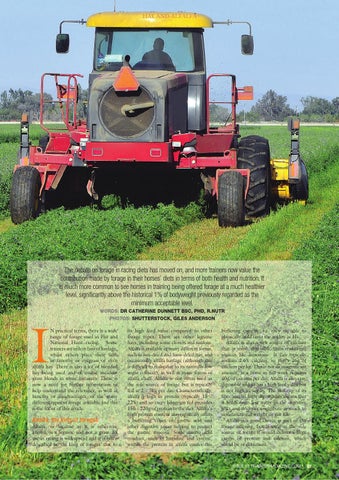hAy AND AlfAlfA
The debate on forage in racing diets has moved on, and more trainers now value the contribution made by forage in their horses’ diets in terms of both health and nutrition. It is much more common to see horses in training being offered forage at a much healthier level, significantly above the historical 1% of bodyweight previously regarded as the minimum acceptable level. WORDS: DR CATHERINE DUNNETT BSC, PHD, R.NUTR
I
PHOTOS: SHUTTERSTOCK, GILES ANDERSON
N practical terms, there is a wide range of forage used in flat and National hunt racing. Some trainers are ardent fans of haylage, whilst others place their faith in timothy or ryegrass or even alfalfa hay. There is also a lot of blended hay being used and of course meadow grass blends in some instances. There is now a need for further information to help understand the relevance, as well as benefits or disadvantages, of the many different types of forage available and this is the focus of this article.
Alfalfa, the king of forages
Alfalfa, or lucerne as it is otherwise known, is a legume and not a grass. Its use in racing is widespread and it is often described as ‘the king of forages’ due to
its high feed value compared to other forage types. There are other legume hays, including some clovers and sanfoin. Alfalfa is available in many different forms, such as sun-dried and barn-dried hay, and occasionally alfalfa haylage (although this is difficult to make due to its naturally low sugar content), as well as many forms of alfalfa chaff. Alfalfa is not often used as the sole source of forage but is typically fed at 2 – 5kg per day. Characteristically, alfalfa is high in protein (typically 15 – 22%) and so every kilogram fed provides 150 – 220g of protein to the diet. Alfalfa’s high protein content also reputedly offers a buffering effect on gastric acid and other digestive juices helping to protect the gastric mucosa. Some amino acid residues, such as histidine and cystine, within the protein in alfalfa confer this
buffering capacity; i.e. they are able to physically hold onto the acidity as h+. Alfalfa is also a rich source of calcium that is more digestible than traditional sources like limestone. It can typically contain 2.6% calcium, so that’s 26g of calcium per kg. This is not an insignificant amount, as a horse in full work requires 40g of calcium per day. Alfalfa is also very digestible and so has a high feed value but is not high in sugars. The makeup of its fibre and its high digestibility means that it holds onto less water in the digestive tract and does not contribute as much to non-functional weight or gut fill. Alfalfa is a good choice as part of the forage offering, but if used as the sole source of forage it would deliver a large excess of protein and calcium, which could be of detriment.
ISSUE 53 TRAINERMAGAZINE.COM
37
